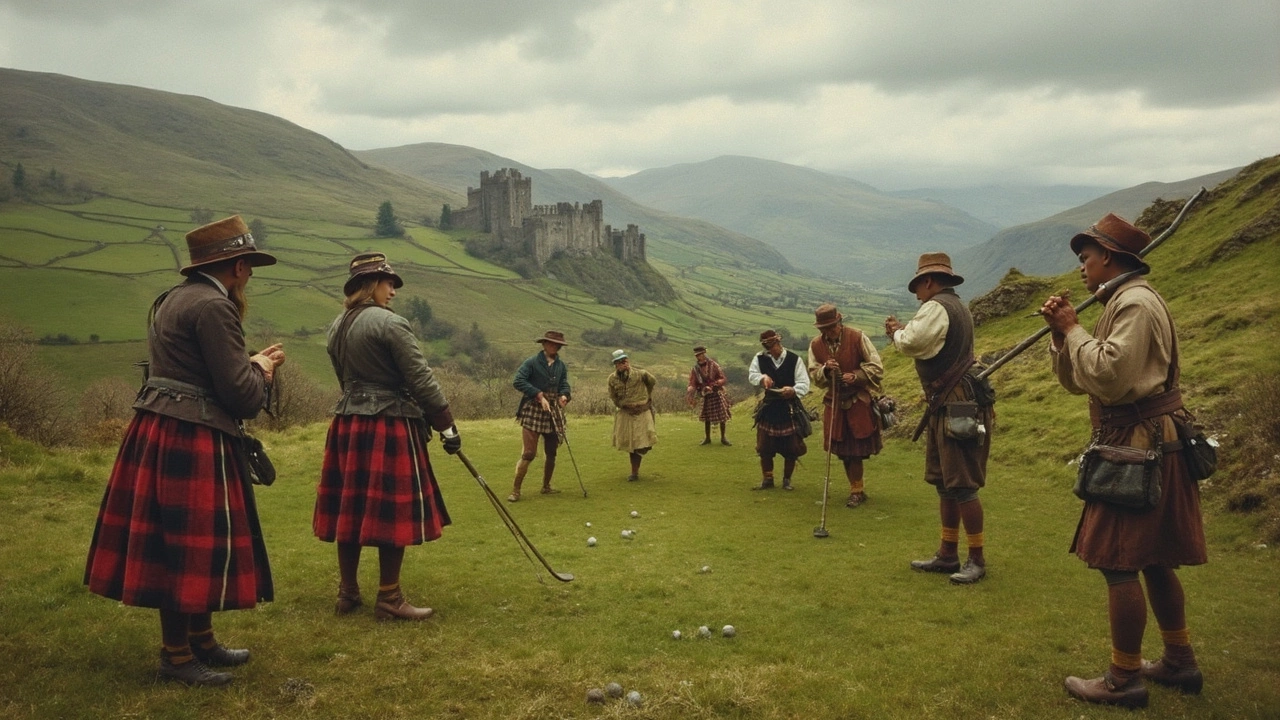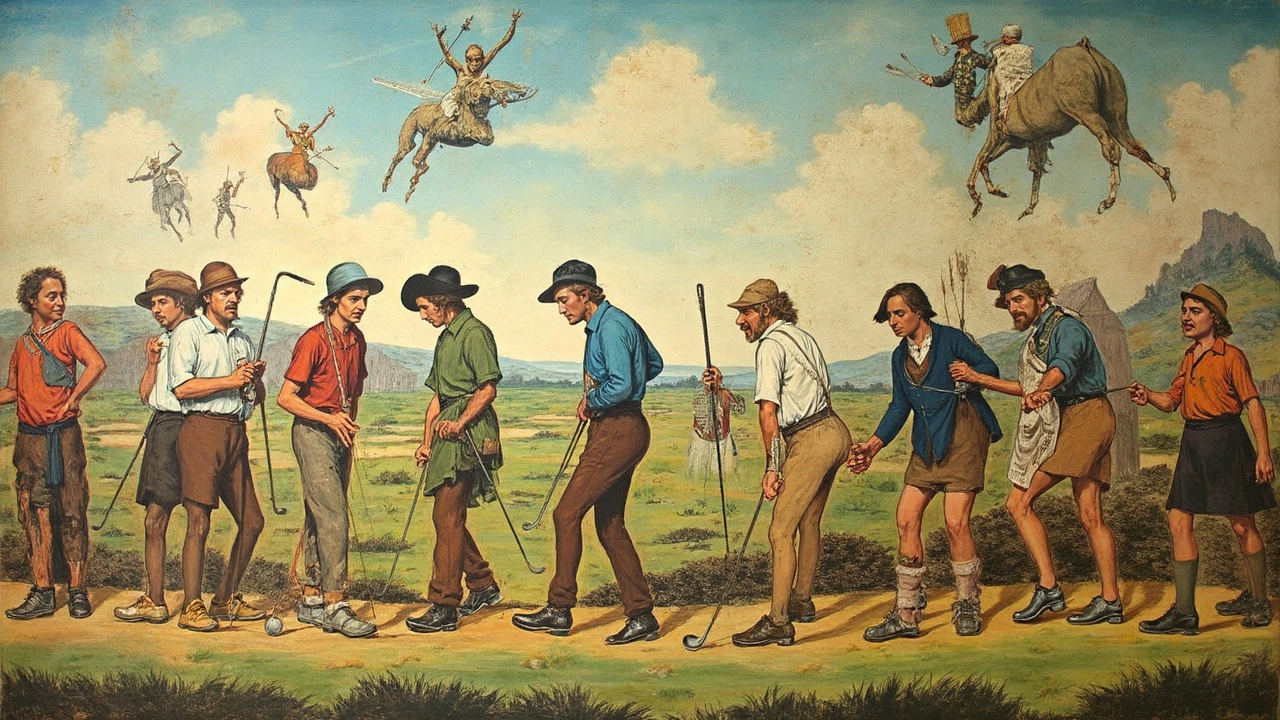Discovering the Origins of Golf: A Journey Through Time

Have you ever wondered who dreamed up the game of golf? It's got a long, winding history full of tales that might surprise you. While most folks usually think of Scotland when they think of golf, its earliest roots might stretch far beyond the Highlands. Ancient versions of the game were played in countries like China and the Netherlands, long before the Scots picked up their first golf clubs.
In Scotland, around the 15th century, golf became more than just a pastime—it was an art form celebrated by royalty. Legend has it that James II of Scotland even banned the game in 1457. Why, you ask? Because it distracted folks from practicing their archery. Luckily, the ban didn’t last, and Scotland became the true birthplace of modern golf.
- Origins in Ancient Times
- Scotland's Role in Shaping Golf
- The Evolution of Equipment
- The Spread of Golf Worldwide
- Influential Figures in Golf History
Origins in Ancient Times
While the rolling greens of Scotland get much of the credit for golf, it turns out this sport's ancient roots might actually dig into some pretty unexpected locations. Believe it or not, some historians suggest that a game similar to golf was played in China during the Song Dynasty, way back in the 13th century. Known as 'chuiwan,' this game involved players using a stick to hit a ball into a series of holes, sound familiar?
Meanwhile, in the Netherlands around the 12th century, locals engaged in a game called 'kolf.' This game involved hitting a leather ball towards a target, which could have been anything from a post to a tree off in the distance. While not quite the game of golf we recognize today, these early versions certainly planted the seeds for what was to come.
Connections to Modern Golf
These ancient games might not have the sand traps or manicured lawns of our modern golf courses, but they sure had elements that hint at where things would eventually head. The basic idea of striking a ball toward a destination is at the heart of these games, showing how universal this kind of pastime really is.
Interestingly, evidence suggests that these games were mostly enjoyed by different social classes, from peasants to nobility. This widespread appeal is something that golf has carried with it through the ages.
So, the next time you tee off, remember you're taking part in a tradition that mingles ancient leisure with royal pastimes! It just goes to show that this beloved sport called golf has a history that's as diverse and unpredictable as the game itself.
Scotland's Role in Shaping Golf
When we think of golf history, our minds often drift to Scotland, where rolling greens and heather-covered hills set the stage for the game as we know it today. It wasn't just a pastime; golf was a way of life, echoing through the annals of Scottish history. The first written record of golf in Scotland appeared in 1457 when King James II unsuccessfully attempted to ban the game. He believed it was a distraction from archery, a skill deemed critical to national defense at the time.
Early Days on the Links
Scotland's landscape played a huge role in the development of golf courses. The natural terrain of the links, coastal sand dunes, provided the perfect foundation for the sport. Courses like St. Andrews, often referred to as 'The Home of Golf', date back to the early 15th century and are still a staple in the realm of prestigious courses.
"There is no sport more Scottish than golf." - Sir John Lubbock, a noted historian.
By the 18th century, golf had gained incredible popularity, leading to the establishment of some of the game's oldest institutions. The Honourable Company of Edinburgh Golfers, established in 1744, and the Royal and Ancient Golf Club of St Andrews, formed in 1754, laid the foundations for rules that still influence the game today.
The First Golf Tournament
Trivia time: Did you know the first-ever golf tournament took place in Scotland? It all went down in 1860 at Prestwick Golf Club, where professionals gathered to showcase their skills in what would become The Open Championship. This event highlighted Scotland's pivotal role in taking golf beyond its borders.
| Year | Event |
|---|---|
| 1457 | First record of golf in Scotland |
| 1744 | Establishment of the Honourable Company of Edinburgh Golfers |
| 1860 | First Open Championship at Prestwick |
So, next time you tee up, think of Scotland's lasting legacy and its deep, enduring connection to the sport we know and love.

The Evolution of Equipment
Ever thought about how those fancy clubs in the golf store came to be? Well, buckle up, because the evolution of golf equipment is quite a ride. From humble beginnings with simple wooden sticks to today's high-tech marvels, there's a lot of history packed into those golf bags.
From Wood to Steel
Back in the day, the very first clubs were crafted from wood. We're talking trees, naturally, but the preferred choice was usually beech or ash for the shafts and fruitwood like apple or pear for the heads. Then along came the 20th century, and with it, more durable materials like steel. This not only made clubs stronger but also a lot more precise.
The Ball's Story
Then there's the golf ball, which has seen some wild changes. Starting as a leather pouch stuffed with feathers, over time it transformed into a solid rubber core design. The introduction of the solid-core ball with a surlyn cover in the 1960s revolutionized how the game was played. These changes aren't just bells and whistles—they genuinely improved players' abilities to perfect their game.
"Golf equipment advances have transformed the sport from quaint pastimes to professional championships." - Golf Digest
Technological Shifts
Today, golf clubs are like pieces of art, thanks to computer-aided designs and materials like graphite and titanium. These help strike a balance between lightness and power. It's no wonder that pros and amateurs alike are utterly obsessed with tweaking even the smallest of details to enhance their performance.
It's also fascinating to note how technology hasn't stopped with the clubs. Innovations in golf shoes, GPS watches, and smart rangefinders add layers of sophistication to the game that would baffle golfers from a century ago.
With all these changes, one thing stays the same: golf remains a game of skill, patience, and a bit of luck. As they continue to refine equipment, both the challenges and joys of the game grow. So next time you're about to tee off, give a nod to the ingenious journey that brought you your trusty golf gear.
The Spread of Golf Worldwide
After solidifying itself in Scotland, golf didn't just stay there. It packed its bags and traveled far and wide, capturing hearts across continents. By the 19th century, the game had hopped over to the British colonies, making its mark in countries like India and Australia.
One of the game's biggest leaps was into the United States. The first documented round of golf in the U.S. took place in Charleston, South Carolina, back in 1786. However, it wasn't really until the late 1800s that golf truly boomed, with the establishment of the United States Golf Association (USGA) in 1894, which set the stage for the organized expansion of golf courses and tournaments across the country.
Europe and Beyond
Across Europe, golf was steadily gaining traction as well. Prestigious clubs were popping up in places like France and Italy during the late 19th and early 20th centuries. Meanwhile, the Netherlands and Germany each developed their own golfing communities, sparked by the appeal of the green fairways.
Something fascinating happened as golf spread. Each region put its own twist on the game. While Scotland remains the heart with its rugged links courses, countries like Japan and South Africa have introduced stunning landscapes and diverse environments for the sport.
The Rise of Global Tournaments
Today, golf boasts a variety of international tournaments that draw in players and fans from every corner of the globe. Who could forget events like The Open Championship and The Masters? If you're a golf enthusiast, these tournaments are like a second home, projecting golf onto a worldwide stage and creating a truly international sport.
The expansion isn't just cultural—it's technological too. With advancements in digital media, golf has found a digital home, with professionals and amateurs alike sharing tips, experiences, and more.

Influential Figures in Golf History
When you think about the history of golf, several key figures come to mind who have had a massive impact on the game. These trailblazers not only shaped how the game is played but also its cultural significance.
The Old Tom Morris Saga
Let's start with Old Tom Morris, the Scottish greenskeeper turned golf pioneer who was instrumental in the development of courses and equipment during the 19th century. Known as the grand architect behind the St Andrews Links, Morris is a golf legend. His influence on the game is seen in his development of the 18-hole course format and innovations in maintenance, revolutionizing golf courses forever.
Bobby Jones and His Grand Slam
Over in the States, Bobby Jones is synonymous with golf excellence. Jones achieved something magical in 1930 by winning the Grand Slam of golf, a feat of clinching all major championships of that era in a single calendar year. What’s even more impressive is his decision to retire from competitive golf at the ripe age of 28, focusing instead on co-founding the Masters Tournament at Augusta National, which remains one of the most prestigious events worldwide.
Arnold Palmer: The People's Champ
Jumping into more recent history, Arnold Palmer changed how golf was perceived. Known as "The King," Palmer was not just a player; he was a people's champion. His charisma brought golf to television screens everywhere, turning it into a sport for the masses. The surge in golf's popularity during the 1960s is largely credited to him, and thanks to his engaging personality, golf clubs and courses saw a boom in membership and participation.
Tiger Woods, A Modern Game Changer
No conversation about influential figures is complete without mentioning Tiger Woods. He redefined the game in terms of athleticism and popularity. Woods’ ability to draw new audiences to the sport and challenge age-old records has left a long-lasting footprint on both the game and its equipment. His strategic play and phenomenal success on the course broke barriers for athletes worldwide and has inspired a new generation of diverse players, spurring growth in golf courses globally.
These figures are just the tip of the iceberg, but they exemplify how individuals have left a lasting legacy on the game of golf. Whether it's through architectural innovations, legendary tournament wins, or expanding the game's audience, their contributions have shaped golf into the beloved sport it is today.




